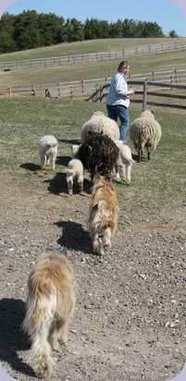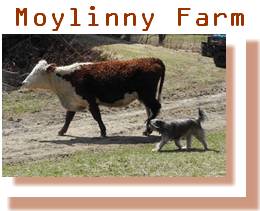



 If you would like to experience
this challenging sport or if you just want a useful helper on your
farm you first need to have access to a few sheep to start your dog's training.
Usually 3 sheep are enough to create a mini-herd but the more the merrier
as more sheep are easier to control than a few. There are trainers
all across Canada and the United States that will help you get started.
An instructor at your local dog training school may be able to put you onto
the closest sheep herding facility in your area. A herding instructor
will show you what the sheep are doing and what your dog wants to do with
them, and where you come into the picture.
If you would like to experience
this challenging sport or if you just want a useful helper on your
farm you first need to have access to a few sheep to start your dog's training.
Usually 3 sheep are enough to create a mini-herd but the more the merrier
as more sheep are easier to control than a few. There are trainers
all across Canada and the United States that will help you get started.
An instructor at your local dog training school may be able to put you onto
the closest sheep herding facility in your area. A herding instructor
will show you what the sheep are doing and what your dog wants to do with
them, and where you come into the picture.
There are only a few commands that your Pyr Shep needs to know; "STOP", "AWAY TO ME", "COME BYE", "THERE" AND "WALK UP" . The most important command which can be taught anywhere and anytime is "STOP". You can start your puppy or adult dog learning what "STOP" means by stopping his movement, on a leash, and saying the word "STOP". He will quickly learn that "STOP" means to stop moving. Any herding instructor will appreciate you being able to stop your pup's enthusiasm when first starting out herding. Often a young dog will get caught up in a game of chasing sheep and if you have a reliable "STOP" on your dog it is the quickest way to regain control of him. A useful exercise is for you to just stand or sit among the flock of sheep with your dog calmly standing and watching the animals. This relaxes the dog for the purpose of ease of training, and it also is an opportunity for your dog (and yourself) to watch and learn about the sheep. There is a lot of communication going on between animals that we are not aware of and this in itself is a training exercise.

"WALK UP" is the command you give when you want your dog to move in a straight
line towards the sheep. This pushes the sheep away from the dog.
You can tell your dog to "WALK UP" and then "STOP" when the sheep have moved
the desired distance.

The above pictures shows a young Pyr
Shep circling clockwise at the back of four chickens. This is a "COME
BYE" command. Circling anti-clockwise is an "AWAY TO ME" command.
Once the dog is where you would like it to be then you say "THERE" and that
should indicate to the dog to stop around that spot and take the next command,
usually a "WALK UP".


Here our Pyr Shep, Hoopla, is helping me take out three lambs for a graze.
Our first stop is the apple tree. While the sheep are eating apples
the Pyr Sheps also indulge in an apple or two.
When all is calm there is no need to keep your dog working the sheep.
It is handy to have an On and Off switch. Most Pyr Sheps are very
happy to oblige and their main focus is their master.
After stopping at the apple tree I set off to different areas of the neighbourhood
which provides the sheep with lots to eat and the dogs with lots of chores
to perform.
Then over the bridge and into
the woods 

On the other side of the woods
is the grazing pasture. 
"THAT'LL DO" is a command you
often hear which tells the dog that you no longer want his help and to stop
working.
or go to You Tube
http://www.youtube.com/watch?v=lsGNgwO5oBg&feature=youtube_gdata

Ch.Chaparral's Niveole HT lives in California helping out with the sheep in the vineyards of Manzanita Organics as well as training up the team! She has even been reported to have attacked a theatening Bobcat & Coyote! |

Olivia helping me take the sheep to graze. |

Chaparral's Pansy keeping the cattle in line at her farm http://www.refordbeef.ca Videos of Pansy working her cattle: https://youtu.be/sRxFQJGy9uM https://youtu.be/eo6wzbc4_c4 A FABULOUS video of Honey moving cattle for vetting day. https://youtu.be/1C-06_OTORo |

Chaparral's Pooka 2nd watches over her flock grazing at Amblecroft Farm |
Many of our dogs are used on farms and
have proven themselves invaluable working on all types of livestock.
 back
to Trialing with Pyr Sheps
back
to Trialing with Pyr Sheps